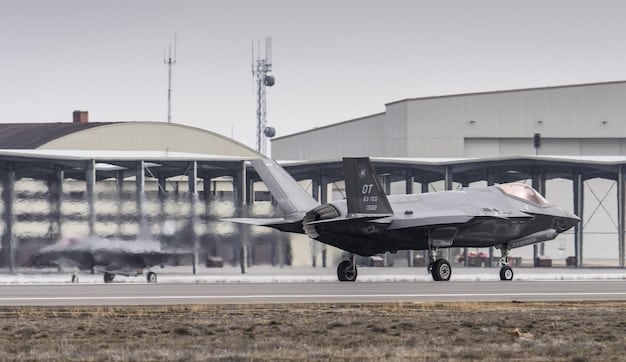US Defense Spending Hike 2025: Contractor Impact Analysis

The projected 7% increase in US defense spending for 2025 is set to significantly reshape the landscape for contractors, driving demand for advanced technologies, enhancing job creation, and fostering innovation across key sectors while also presenting complex challenges in supply chain management and regulatory compliance.
As the United States government signals a potential 7% increase in defense spending for 2025, stakeholders across the defense industry are bracing for a transformative period. This significant budgetary adjustment promises to ripple through various sectors, profoundly impacting US contractors. From innovative technological advancements to a reshaped competitive landscape, understanding the multifaceted implications is crucial for businesses aiming to thrive in this evolving environment.
Understanding the Landscape of Increased Defense Spending
The announcement of a projected 7% increase in US defense spending for 2025 is not merely a number; it represents a strategic pivot in national security priorities and an economic catalyst. This boost in the defense budget is typically driven by a confluence of geopolitical tensions, technological imperatives, and a desire to maintain military superiority. For contractors, this translates into a heightened demand for their services and products, but it also necessitates a nuanced understanding of where these funds will be allocated. The defense budget is a complex organism, with allocations spread across various domains, including research and development, procurement, operations and maintenance, and various personnel costs. Each segment presents unique opportunities and challenges for the contractor base.
Historical Precedents and Current Drivers
Examining past periods of increased defense spending reveals typical patterns of impact on contractors. Historically, surges in defense budgets have led to periods of rapid growth for companies specializing in areas deemed critical for national security. Current drivers for the 2025 increase likely include ongoing conflicts, the rise of near-peer competitors, and the urgent need to modernize aging military assets. This includes investments in:
- Advanced missile defense systems to counter emerging threats.
- Cybersecurity infrastructure to protect critical networks.
- Next-generation aircraft and naval vessels for enhanced operational capabilities.
The emphasis is consistently on maintaining a qualitative edge, which invariably benefits contractors capable of delivering cutting-edge solutions. This growth trajectory, however, is often accompanied by increased scrutiny and competition.
The strategic allocation of these funds is paramount. While some increases might be broadly distributed, significant portions are often earmarked for specific, high-priority programs. Contractors must therefore strategically align their capabilities with these designated areas. Anticipated areas of focus include enhanced readiness, artificial intelligence integration, space capabilities, and resilient supply chains. The Department of Defense (DoD) often signals these priorities through solicitations and public statements, providing valuable insights for industry players. Success in this evolving environment demands a proactive approach to understanding and responding to these shifting priorities.
Opportunities for US Defense Contractors
A 7% increase in defense spending presents a robust array of opportunities for US contractors, spanning from established giants to innovative smaller businesses. This financial injection will likely fuel demand across several critical areas, fostering growth, innovation, and expansion within the defense industrial base. Contractors agile enough to adapt to emerging needs and capable of delivering high-quality, cutting-edge solutions stand to benefit significantly. The opportunities are not merely about increased contracts, but also about the scope and complexity of the projects that such funding can support.
Expanded Procurement and Modernization Programs
One of the most direct impacts will be seen in expanded procurement budgets and accelerated modernization programs. The DoD consistently seeks to upgrade its capabilities, replace aging equipment, and adopt new technologies. A significant budget increase will allow for faster acquisition cycles and larger contract awards for items such as:
- Next-generation fighter jets and bombers, incorporating stealth and advanced avionics.
- Naval shipbuilding, including new frigates, destroyers, and submarines, to maintain maritime superiority.
- Ground vehicle modernization, focusing on enhanced protection, mobility, and networked capabilities.
These programs are capital-intensive and require long-term commitments, providing stability for prime contractors and their extensive supply chains. The demand for these platforms also drives concurrent needs for maintenance, spare parts, and training, creating a broader ecosystem of opportunity.
The modernization efforts extend beyond physical assets, encompassing software, data analytics, and intelligence systems. Contractors specializing in these domains can expect increased investment in developing and integrating advanced digital capabilities into existing and future military systems. This includes sophisticated command and control systems, predictive maintenance software, and robust data security solutions, all critical for maintaining a technological advantage. The emphasis on these areas signals a shift towards a more digitally integrated and responsive defense force, creating new niches for specialized contractors.
Research and Development (R&D) and Technological Innovation
Increased funding invariably translates into a greater emphasis on research and development (R&D). The DoD relies heavily on external partners to drive technological innovation, seeking breakthrough solutions that can provide asymmetric advantages. Contractors engaged in R&D will find enhanced opportunities for funding grants, partnerships with government labs, and contracts for developing advanced prototypes. This fosters a vibrant ecosystem of innovation, from basic science to applied engineering, across various cutting-edge fields.
This R&D push will prioritize emerging technologies such as:
- Artificial Intelligence (AI) and Machine Learning (ML) for autonomous systems, data analysis, and decision support.
- Hypersonic weapon systems, both offensive and defensive, to counter sophisticated threats.
- Quantum computing and cryptography for secure communications and advanced sensing.

These areas require significant investment, high-risk development cycles, and specialized expertise, making them natural fits for innovative contractors. The potential for long-term intellectual property development and subsequent commercial ventures also makes these R&D opportunities particularly attractive. The ultimate goal is to translate cutting-edge scientific discoveries into deployable military capabilities.
Furthermore, the increase in R&D funding often trickles down to smaller, specialized firms and academic institutions. These entities often act as vital incubators for novel ideas, providing innovative solutions that larger prime contractors might then integrate into broader systems. This creates a highly interconnected innovation network, promoting collaboration and the rapid development of new defense technologies.
Challenges and Considerations for Contractors
While increased spending creates numerous opportunities, US defense contractors must also navigate a complex landscape of challenges. The influx of funds often brings heightened scrutiny, increased competition, and more stringent requirements. Companies that are not prepared for these complexities may struggle to fully capitalize on the potential benefits. Understanding and strategically addressing these challenges will be key to sustainable growth and success in 2025 and beyond.
Navigating Increased Competition and Market Saturation
A larger budget often attracts more players to the defense market, intensifying competition. Both established primes and emerging technology companies will vie for a share of the new contracts. This can lead to downward pressure on pricing, requiring contractors to demonstrate superior value, efficiency, and innovative solutions to secure bids. Smaller businesses, in particular, may find it challenging to compete against larger, more resourced organizations.
To counter this, contractors will need to:
- Invest in differentiation through specialized capabilities and unique intellectual property.
- Focus on cost efficiency and lean operational models to maintain competitiveness.
- Form strategic partnerships and joint ventures to expand capabilities and market reach.
Building a strong reputation for reliability, quality, and timely delivery will become even more critical. The emphasis will shift from simply being able to perform a task to being the most effective and efficient performer available. Furthermore, the increased competition may also come from non-traditional defense players, particularly in software and AI, forcing incumbents to innovate rapidly.
Supply Chain Resilience and Cybersecurity Threats
The global supply chain continues to be a vulnerability for the defense industry. Increased demand due to higher spending will invariably place greater strain on these supply chains, potentially exacerbating existing issues related to material availability, logistics, and cost fluctuations. Contractors must prioritize building resilient and diversified supply chains to mitigate risks and ensure project continuity. This includes identifying alternative suppliers, increasing inventory buffers, and investing in domestic manufacturing capabilities where possible.
Compounding this challenge are persistent and evolving cybersecurity threats. Defense contractors, as custodians of sensitive information and critical technologies, are prime targets for state-sponsored and criminal cyberattacks. A 7% spending increase means more data, more projects, and potentially more vulnerabilities. Contractors must significantly bolster their cybersecurity defenses, not only to protect their own networks but also to safeguard the integrity of the entire defense ecosystem. This involves:
- Implementing robust cybersecurity protocols and continuous monitoring systems.
- Investing in employee training to recognize and respond to cyber threats.
- Adhering to strict government cybersecurity regulations and standards, such as CMMC.
Failure to address these supply chain and cybersecurity issues can result in significant project delays, cost overruns, and severe reputational damage. The increased emphasis on these areas by the DoD will also likely lead to stricter compliance requirements, placing additional burdens on contractors.
Impact on Different Contractor Segments
The projected 7% increase in defense spending will not impact all contractors equally. Its effects will vary significantly depending on a contractor’s specialization, size, and strategic alignment with DoD priorities. Understanding these differentiated impacts is crucial for strategic planning and positioning within the defense industrial base. From large prime contractors to small tech startups, each segment will experience both unique opportunities and specific challenges as the budgetary landscape shifts.
Prime Contractors and Large Integrators
Large prime contractors and integrators, such as Lockheed Martin, Raytheon Technologies, and Northrop Grumman, are likely to be the primary beneficiaries of this spending increase. They are responsible for delivering major weapon systems, complex platforms, and large-scale integration projects. The 7% boost will translate into larger contracts, expanded production lines, and increased R&D funding for their core programs. Their established relationships with the DoD, extensive infrastructure, and proven track record position them well to capture a significant portion of the new spending.
The opportunities for primes often involve:
- Leading new development programs for next-generation platforms.
- Securing multi-year sustainment and modernization contracts for existing systems.
- Expanding international sales of US-made defense equipment, often facilitated by government-to-government agreements.
However, primes will also face increased pressure to deliver on schedule and within budget, especially given the public scrutiny that often accompanies large defense contracts. They will also need to manage complex global supply chains and a vast network of subcontractors, ensuring compliance and quality across the board. The enhanced funding could also intensify the focus on competitive bidding, even for incumbent contractors.
Small and Medium-Sized Businesses (SMBs)
Small and medium-sized businesses play a vital role in the defense industrial base, often serving as critical suppliers, innovators, and specialized service providers. For many SMBs, the 7% spending increase could unlock new avenues for growth, particularly if they align with niche technological needs or provide specialized components overlooked by larger primes. Government initiatives aimed at promoting small business participation, such as set-aside contracts, might see increased funding and attention, creating more direct opportunities.
SMBs specializing in emerging technologies like AI, robotics, advanced materials, and cybersecurity are particularly well-positioned. Their agility and innovative capacity can be highly attractive to the DoD seeking rapid prototyping and cutting-edge solutions. The opportunities for SMBs may include:
- Securing contracts through Small Business Innovation Research (SBIR) and Small Business Technology Transfer (STTR) programs.
- Becoming critical technology providers or niche component suppliers to prime contractors.
- Offering specialized consulting, engineering, or IT services to the DoD or larger defense firms.

The challenge for SMBs will be scaling operations to meet increased demand, navigating complex government contracting regulations, and adequately protecting intellectual property. Access to capital and skilled labor may also become more competitive with increased activity in the sector. Building strong relationships with prime contractors and understanding their procurement processes will be crucial for SMBs looking to become part of larger defense programs.
Long-Term Economic and Employment Impacts
The projected 7% increase in US defense spending for 2025 extends its influence far beyond the immediate financial transactions within the defense industry. It acts as a significant economic stimulus, with long-term implications for employment, regional economies, and the broader technological landscape. Understanding these ripple effects provides a more complete picture of the increase’s total impact, highlighting both its benefits and potential societal trade-offs. The defense sector, while specialized, often generates widespread economic benefits through its extensive supply chains and technological spin-offs.
Job Creation and Workforce Development
Increased defense spending is a well-documented driver of job creation. A 7% budget increase will likely lead to a substantial demand for skilled labor across various disciplines. This includes engineers, scientists, manufacturing technicians, project managers, cybersecurity experts, and many other support functions. As contractors scale up to meet new contract requirements, they will need to expand their workforces, leading to direct job growth within the defense industry.
Beyond direct employment, the defense sector generates significant indirect and induced jobs. Indirect jobs are created in industries that supply goods and services to defense contractors, such as raw materials, IT support, and logistics. Induced jobs arise from the spending of wages earned in the defense sector and its suppliers, stimulating local economies. This can lead to:
- Increased demand for specialized engineering and technical education programs.
- Enhanced apprenticeship opportunities in advanced manufacturing and skilled trades.
- Growth in support services, from hospitality to retail, in areas surrounding defense installations and contractor facilities.
The concentration of defense contractors in specific regions often means that these local economies will experience a significant boost in employment and economic activity. However, ensuring a sufficiently skilled workforce will be a challenge, requiring ongoing investment in training and education programs to meet the evolving demands of the defense industry.
Regional Economic Growth and Technological Spinoffs
The geographic distribution of defense spending often results in concentrated regional economic growth. States and localities with a strong presence of defense contractors or military bases stand to benefit disproportionately from increased funding. These regions experience higher investment in infrastructure, increased tax revenues, and a general stimulation of local businesses. This creates economic clusters where specialized knowledge and manufacturing capabilities can thrive, attracting further investment and talent.
Furthermore, the significant R&D investments within the defense sector frequently lead to technological spinoffs with broader commercial applications. Innovations developed for military purposes often find their way into civilian life, driving advancements in various industries. Examples include GPS technology, advanced materials, and sophisticated sensor systems, all of which originated or were significantly advanced through defense funding. This contributes to:
- Development of dual-use technologies that can serve both military and commercial markets.
- Enhanced competitiveness of US industries in global technology markets.
- The creation of entirely new commercial sectors based on defense-funded research.
While the primary objective of defense spending is national security, its secondary effect as a catalyst for technological progress and economic development is undeniable. However, over-reliance on defense spending can also make regional economies vulnerable to future budget cuts, highlighting the need for diversification. The long-term economic prosperity linked to defense expenditures is therefore a complex balance of opportunities and strategic regional planning.
Geopolitical Context and Policy Implications
The projected 7% increase in US defense spending for 2025 is not an isolated financial decision; it is deeply embedded within a broader geopolitical context and carries significant policy implications. This budgetary shift reflects a strategic response to evolving global challenges and aims to solidify the United States’ position on the world stage. For US defense contractors, understanding this overarching framework is paramount, as it dictates the priorities, requirements, and long-term trajectory of the industry. The interplay between foreign policy, national security objectives, and budgetary allocations is a critical lens through which to view the future of defense contracting.
Global Power Dynamics and Strategic Priorities
The decision to significantly increase defense spending is often a direct response to shifts in global power dynamics. The rise of near-peer adversaries, ongoing conflicts, and the proliferation of advanced military technologies worldwide necessitate a robust and adaptable defense posture. The 7% increase signifies a commitment to maintaining a qualitative and quantitative military edge. This impacts contractors by:
- Directing investments towards capabilities that counter specific threats, such as advanced anti-access/area denial (A2/AD) systems or sophisticated cyber warfare tools.
- Prioritizing alliances and partnerships, potentially leading to increased foreign military sales and collaborative development programs with allied nations.
- Emphasizing readiness and deterrence in key strategic regions, driving demand for sustainment and operational support contracts.
These strategic priorities will filter down to contractors in the form of specific program requirements and technological demands. Companies that can demonstrate alignment with these high-level objectives, offering solutions that directly address the most pressing national security concerns, will be at a significant advantage. The geopolitical landscape is a constant driver of innovation and expenditure within the defense sector.
Regulatory Environment and Export Controls
With increased defense spending comes heightened scrutiny and a complex regulatory environment. US defense contractors operate within a strict framework of laws and regulations governing everything from contract acquisition to intellectual property protection and export controls. The 7% increase will likely lead to even greater emphasis on compliance, transparency, and accountability, particularly given the public and political attention associated with large defense budgets.
Key regulatory considerations for contractors include:
- Adherence to the Foreign Corrupt Practices Act (FCPA) and other anti-bribery statutes, especially when engaging in international sales.
- Compliance with the International Traffic in Arms Regulations (ITAR) and Export Administration Regulations (EAR) when exporting defense articles and services.
- Stringent cybersecurity requirements, such as those mandated by the Cybersecurity Maturity Model Certification (CMMC), to protect sensitive government information.
Navigating these regulations can be resource-intensive and requires specialized expertise. Non-compliance can result in severe penalties, contract forfeiture, and reputational damage. While these regulations present a barrier to entry for some, for established contractors with robust compliance programs, they represent a necessary cost of doing business and an assurance of responsible operations. The increasing complexity of military technology and global supply chains demands careful navigation of these legal and policy frameworks.
Future Outlook and Adaptability for Contractors
The projected 7% increase in US defense spending for 2025 undeniably signals a period of significant change and opportunity. For defense contractors, successfully navigating this evolving landscape will depend heavily on their ability to anticipate future trends and demonstrate robust adaptability. The defense industrial base is dynamic, shaped by technological advancements, geopolitical shifts, and policy decisions. Contractors that embrace foresight and flexibility will be best positioned to thrive in the years to come.
Emerging Technologies and Market Shifts
The defense sector is a hotbed of technological innovation, and future spending increases will continue to prioritize emerging technologies. Contractors must actively monitor and invest in research and development related to areas such as:
- Integrated multi-domain operations (MDO), requiring seamless collaboration across land, sea, air, space, and cyber domains.
- Advanced manufacturing techniques, including additive manufacturing (3D printing) for rapid prototyping and localized production.
- Enhanced sensor technologies and data fusion for superior situational awareness and decision-making.
These technological shifts will create new market segments and disrupt existing ones. Contractors that fail to adapt their offerings to these emerging needs risk obsolescence. This requires a proactive approach to technology scouting, internal R&D, and strategic partnerships with startups and academic institutions at the forefront of innovation. The ability to quickly integrate new technologies into existing platforms and develop entirely new capabilities will be a key differentiator.
Strategic Partnerships and Diversification
In an increasingly complex and competitive environment, strategic partnerships will become even more crucial. Contractors, both large and small, can benefit from forming alliances that enhance their capabilities, expand their market reach, and share the risks associated with large defense programs. This can include:
- Joint ventures between prime contractors to bid on mega-projects.
- Partnerships between established defense firms and cutting-edge tech startups to integrate novel solutions.
- Collaborations with international partners for co-development and foreign military sales opportunities.
Beyond partnerships, diversification can offer resilience. While the 7% increase is positive, defense spending can be volatile. Contractors that diversify their client base (e.g., government agencies beyond the DoD, international markets) or their product offerings (e.g., dual-use technologies with commercial applications) can mitigate risks associated with future budget fluctuations. This strategic foresight ensures long-term stability and reduces dependence on a single funding source.
The defense industrial base is also seeing a greater emphasis on sustainability and ethical practices. Contractors that integrate environmental, social, and governance (ESG) principles into their operations may find themselves with a competitive advantage, as increasingly, the DoD and other stakeholders consider these factors in procurement decisions. This broader view of corporate responsibility aligns with global trends and contributes to a more resilient and responsible industry. Companies that can demonstrate a commitment to these values along with technological prowess will likely emerge as leaders in the future defense market.
Navigating the Future: Key Strategies for Success
The anticipated 7% increase in US defense spending for 2025 presents a unique inflection point for defense contractors. It offers robust avenues for growth and innovation but also demands a sophisticated approach to challenges ranging from market competition to supply chain vulnerabilities. Success in this heightened funding environment will hinge on a contractor’s ability to not only identify and seize opportunities but also to proactively mitigate risks and adapt to evolving priorities. Strategic planning and a commitment to continuous improvement are paramount.
One of the most critical strategies for contractors will be aligning their capabilities directly with the DoD’s explicitly stated and emerging priorities. This means staying abreast of defense strategy documents, budget requests, and high-level speeches from defense leaders. Understanding where the greatest needs lie—whether in artificial intelligence, hypersonic technology, or space-based defenses—is essential for directing internal investments and bidding effectively. A precise understanding of the strategic landscape allows for targeted innovation and resource allocation.
Furthermore, fostering a culture of agility and innovation within their organizations will be vital. The defense landscape is characterized by rapid technological advancement and evolving threat vectors. Contractors must be able to quickly pivot, develop, and integrate new solutions. Embracing lean methodologies, promoting cross-functional collaboration, and investing in continuous employee training in emerging fields will enable companies to remain at the forefront of defense technology. This agility also extends to navigating the often-complex procurement and contracting processes of the government.
Finally, a strong emphasis on cost-efficiency and performance will continue to be a cornerstone of success. While more funding is available, the DoD remains focused on maximizing taxpayer value and demanding high performance. Contractors that can demonstrate superior efficiency, reliable project delivery, and robust quality control will distinguish themselves. This includes optimizing internal operations, leveraging digital transformation tools, and implementing rigorous program management practices. The combination of innovation, strategic alignment, and operational excellence will define the most successful US defense contractors in 2025 and beyond.
| Key Point | Brief Description |
|---|---|
| 🚀 Increased Demand | Expect higher contract volumes and accelerated modernization programs across all defense sectors. |
| 💡 Innovation Drive | Significant R&D funding for AI, hypersonics, and quantum technologies will create new opportunities. |
| 🔗 Supply Chain Scrutiny | Greater focus on resilience and cybersecurity within defense supply chains is anticipated. |
| 💼 Job Growth | The spending increase will lead to substantial job creation across various technical and manufacturing roles. |
Frequently Asked Questions About Defense Spending
While exact allocations are always evolving, traditional areas like advanced aircraft, naval vessels, and ground systems will see modernization. Emerging technologies such as AI, cybersecurity, hypersonic weapons, and space capabilities are high priorities for enhanced investment due to their strategic importance and current geopolitical landscape impact.
Large prime contractors will likely secure major system development and integration contracts. Small businesses will find opportunities through specialized technology niches, R&D programs like SBIR/STTR, and as critical suppliers within primes’ extensive supply chains. Both segments are expected to see growth, but through different mechanisms, requiring varied strategic approaches.
Key challenges include intensified competition from both traditional and new market entrants, ensuring resilient and secure supply chains, and navigating a complex and potentially stricter regulatory environment. Workforce development to meet increased demand for skilled labor and managing inflationary pressures on costs also remain significant hurdles for many contractors.
Yes, historically, increases in defense spending correlate with significant job creation. This includes direct employment in engineering, manufacturing, and technical roles within contractor companies, as well as indirect jobs in supporting industries. It also stimulates regional economies where defense industries are concentrated, leading to broader economic benefits and educational demands.
Cybersecurity is critically important. With more projects and sensitive data, contractors become prime targets for cyberattacks. Stricter compliance with standards like CMMC is expected, requiring robust investment in cybersecurity infrastructure, employee training, and continuous threat monitoring. Protecting sensitive information and operational integrity is paramount for all defense contractors to secure and maintain contracts.
Conclusion
The projected 7% increase in US defense spending for 2025 represents more than just a financial boost; it is a catalyst for significant transformation within the defense industrial base. While promising substantial opportunities for growth in procurement, R&D, and job creation, it simultaneously introduces complex challenges related to competition, supply chain resilience, and an evolving regulatory landscape. Contractors that adopt a forward-thinking approach, prioritizing innovation, strategic alignment with DoD objectives, and robust operational capabilities, will be best positioned to capitalize on this increased investment and contribute meaningfully to national security. The long-term impact will shape technological advancements and economic growth across the nation, underscoring the critical symbiotic relationship between the government’s defense priorities and the capabilities of its industrial partners.





